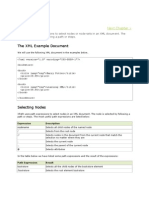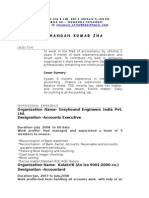0 ratings0% found this document useful (0 votes)
7 viewsLecture 15 Selenium Xpath, Locator Notes
Selenium for software testing
Uploaded by
lubnatahratCopyright
© © All Rights Reserved
Available Formats
Download as DOCX, PDF, TXT or read online on Scribd
0 ratings0% found this document useful (0 votes)
7 viewsLecture 15 Selenium Xpath, Locator Notes
Selenium for software testing
Uploaded by
lubnatahratCopyright
© © All Rights Reserved
Available Formats
Download as DOCX, PDF, TXT or read online on Scribd
You are on page 1/ 3
Lecture 15: Selenium Xpath, locator Notes
Question 1: WHAT IS LOCATOR?
ANSWER: To Capture any web element, we have to use locators. There are different
types of locators in Selenium. There are 8 types of locators By.id(), By.name(), By. Tagname(), By.
Classname(), By. Linktext(), By.partialLinkText(), By.xpath, By.cssSelector(). But among them,
only xpath is most popular and reliable in every company, and some companies use id, name,
and xpath. In the interview, they can ask questions about xpath only.
Question 2: What is the use of xpath?
Answer: Xpath is definitely a locator. It is used to find the web Element on the web page. It is
very useful to identify the dynamic web elements. Xpath is a very powerful locator.
Question 3: What do you mean by Dynamic objects?
Answer: Dynamic object are those which object properties changes frequently.
Question 4: How many types of xpath are there?
Answer: There are different types of xpath. Normally we call 2 types of xpath.
1. Absolute xpath (/ Single slash)
2. Relative xpath (//Double slash)
****Interview Question: What is single slash xpath? Or, Which xpath
do we use? Or, Can you explain about xpath? Or, What is your
understanding of xpath? Or, Do you use locator? Or, What type of
locator do you use for capture the web element?
Answer: There are different types of locators, but we use xpath as locator.
***Interview Question: Which xpath do we use mainly at the office?
Answer: Mainly, we use Relative xpath (// Double slash) at the office.
****Interview Question: What is single slash xpath? OR, Do you have
any knowledge about absolute xpath? OR, Do you know how absolute
xpath works? OR, Do you have any knowledge about single slash
xpath?
Answer: Single Slash xpath is Absolute xpath/ Absolute xpath is called (/Single Slash) xpath.
Absolute or single slash xpath is we have to go from Grandparents, then Parents, then Child
(Grandparents > Parents > Child). In other word, We have to go from the Root to the specific
Object. In that case, if grandparents change, then automatically, parent and child will change. If
anywhere anything changes, then we can’t identify the object. For absolute xpath, we need to
maintain sequence.
****Interview Question: Do you have any idea about double slash
xpath?
Answer: //Double slash is, Relative xpath / Relative xpath is called Double slash xpath. Here,
relative means we are going to specific project, and then we use relative xpath. If I have some
situations in my project, to overcome those situations, I use relative xpath.
***Interview Question: What is the difference between single slash
and double slash xpath?
Answer: Single slash starts from it’s root. We have to go from root to specific
object. That means if anything changes, the path changes automatically. We know
developers always update features or sometimes remove or add features. In that
case, the whole xpath will change, and it will not work anymore, and it will be
valueless. In other words, we can say the single slash/Absolute Xpath is the
relation of Grand Parents > Parents > Child. I have to go from the Root to the
Specific Object. That means, if grandparents change, parents change, if anywhere
anything changes, then we cannot identify the object. We need to maintain the
sequence. That is why we don’t use absolute xpath.
On the other hand, // Double slash is Relative Xpath ( ), and Relative means we
can go to a specific Object. we don’t need to go to it’s root. We use relative Xpath
because it is reliable and popular. In case of this xpath, we can go to the specific
object or code to find a unique xpath directly. So, any change that happens in the
root will not affect this xpath. So, we always prefer //double slash.
Question 5: What is custom xpath?
Answer:
**** We keep our web element in the pageobjectmodel
(POM)package
In this Lecture, we have learned about 3 things about automation First Annotation@ FindBy
Then, we will use the locator, then the webelement, then the name of the webelement, and
then create a method.
You might also like
- Selenium Questions Part2: Selenium Locators: About Me Contact UsNo ratings yetSelenium Questions Part2: Selenium Locators: About Me Contact Us14 pages
- How To Write Effective Xpath Selenium: Xpath //tag - Name (@attribute - Name 'Value')100% (1)How To Write Effective Xpath Selenium: Xpath //tag - Name (@attribute - Name 'Value')6 pages
- Most Exhaustive XPath Locators Cheat Sheet - LambdaTestNo ratings yetMost Exhaustive XPath Locators Cheat Sheet - LambdaTest8 pages
- 04_01_Selenium WebDriver Locators - Part6-XPath in Selenium WebDriverNo ratings yet04_01_Selenium WebDriver Locators - Part6-XPath in Selenium WebDriver45 pages
- Xpath+vs+CSS+-+Everything+you+need+to+know+about+XPath+and+CSS.docxNo ratings yetXpath+vs+CSS+-+Everything+you+need+to+know+about+XPath+and+CSS.docx11 pages
- Day 1 - Selenium IDE - Session 2 - LocatorsNo ratings yetDay 1 - Selenium IDE - Session 2 - Locators20 pages
- How To Write Dynamic Xpath in Selenium:: Findelement (By - Xpath ("Xpath") )No ratings yetHow To Write Dynamic Xpath in Selenium:: Findelement (By - Xpath ("Xpath") )10 pages
- Xpath: Xpath Is Core For XML Query Languages Language For Addressing Parts of An XML DocumentNo ratings yetXpath: Xpath Is Core For XML Query Languages Language For Addressing Parts of An XML Document17 pages
- Top 20 Useful Commands in Selenium WebdriverNo ratings yetTop 20 Useful Commands in Selenium Webdriver25 pages
- Copy-of-CC-MOTHER-NOTES-SIR-BALCE_unlockedNo ratings yetCopy-of-CC-MOTHER-NOTES-SIR-BALCE_unlocked40 pages
- Syllabus For Dispenser Course: Duration - One Year Paper - A Section - I100% (1)Syllabus For Dispenser Course: Duration - One Year Paper - A Section - I4 pages
- The Electronic Structures of Homonuclear Diatomic MoleculesNo ratings yetThe Electronic Structures of Homonuclear Diatomic Molecules12 pages
- الشركات العسكرية و الأمنية الخاصة و دورها كفاعل مؤثر في العلاقات الدولية Private Military and Security Companies and Their Role as Influential Actor in International RelationsNo ratings yetالشركات العسكرية و الأمنية الخاصة و دورها كفاعل مؤثر في العلاقات الدولية Private Military and Security Companies and Their Role as Influential Actor in International Relations22 pages
- Krispy Kreme Doughnuts, Inc.: Statement of The ProblemNo ratings yetKrispy Kreme Doughnuts, Inc.: Statement of The Problem4 pages
- Analysis of The Food Record Fordadang: Hari 1No ratings yetAnalysis of The Food Record Fordadang: Hari 13 pages
- RNA Sequence Structure and Function Computational and Bioinformatic Methods 1st Edition Jan Gorodkin - Download the entire ebook instantly and explore every detail100% (2)RNA Sequence Structure and Function Computational and Bioinformatic Methods 1st Edition Jan Gorodkin - Download the entire ebook instantly and explore every detail84 pages
- Fallout 2d20 - Loot Cards - Wave 4 - The EnclaveNo ratings yetFallout 2d20 - Loot Cards - Wave 4 - The Enclave10 pages

























































































